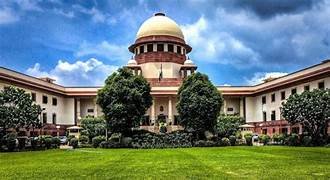Supreme Court restores landlord’s right in 70-year tenancy dispute; tenant eviction ordered and arrears recovery directed.
In a landmark judgment after more than seven decades, the Supreme Court vindicated the landlord’s claim and ordered eviction of long-standing tenants, while directing recovery of rent arrears and giving a six-month vacate window.
The Supreme Court of India (SC) on 11 September 2025 delivered a decisive judgement in a tenancy dispute that had stretched across more than seventy years, ruling in favour of landlord Jyoti Sharma in her suit for eviction against tenants Vishnu Goyal and others. A bench comprising J. K. Maheshwari and K. Vinod Chandran decreed that the tenants must vacate, and ordered the landlord’s claim for rent arrears from January 2000 be recovered. The court also granted the tenants six months to hand over possession of the premises.
A dispute rooted in 1953
The legal saga began with a tenancy in 1953, when the tenant’s family took on lease of a shop premises in which they ran a grocery business — a legacy arrangement that came to be fiercely contested decades later. According to the landlord’s claim, the property was owned by her father-in-law, Ramji Das, and through a will dated 1999, the ownership devolved to his daughter-in-law Jyoti Sharma. Ms Sharma sought to evict the tenants on two major grounds: first, default in rent payments; and second, her bona fide requirement of the premises for expansion of her sweets and savouries business operating next door.
Legal arguments and turn of events
In the eviction suit, the landlord argued that the tenancy had long outlived its legitimate purpose and that the tenants had defaulted on rent since January 2000, leaving her with no alternative but to reclaim the property. The tenants, however, contended that they had been operating the grocery business for generations, enjoyed security of tenure, and that their occupation had continued without interruption. They challenged the landlord’s right to evict after such an extended period and questioned the bona fide requirement claim.
While the judgement does not appear in publicly available repositories yet, the Court’s analysis likely touched upon key legal principles governing landlord-tenant relationships — notably the concept of “bona fide requirement” and long-standing occupancy. Precedents establish that a landlord’s claim must be genuine and sincere, not whimsical, and the requirement must be present-in-fact. Indian Kanoon+2Advocate Gandhi+2 Moreover, the Court in earlier cases has upheld that a long duration of tenancy or the tenant’s occupation does not automatically bar eviction if lawful grounds exist. The Economic Times+1
In this case, the Supreme Court appears to have accepted both limbs of the landlord’s claim: the rent default and the bona fide need for the property. The six-month window to vacate gives the tenants a transitional period before enforcement.
Why this ruling matters
This judgement holds significance on multiple fronts. First, it sends a signal that even long-running tenancy disputes may be brought to a close, provided a landlord can establish valid grounds. The fact that this dispute ran for more than seventy years underscores how protracted such matters can become. Indeed, previous reports show that the Supreme Court has in recent times been called upon to settle tenancy battles spanning decades. The Economic Times+1
Second, the recovery of arrears from January 2000 recognises the economic dimension of tenancy: it is not only about vacating the premises but also about loss of income for the landlord. Third, the judgement provides clarity for landlords who may find themselves in similarly long-drawn disputes, reinforcing the proposition that the law does not indefinitely freeze occupation where grounds for eviction exist.
Finally, for tenants, this ruling highlights the risks of relying solely on longevity of occupancy. While long occupancy may weigh in their favour in some jurisdictions, it does not constitute an immunity from eviction if statutory grounds are found and properly proved.
Implications for commercial tenancies
Although the case concerns a shop tenancy, its implications may ripple into the broader realm of commercial lettings and legacy leases. In many Indian cities, small shops have been under long-term tenancy arrangements with limited formal documentation. This ruling emphasises the importance of clear lease records, timely rent payments and transparency in usage. For landlords, it signals that asserting bona fide requirement for business expansion can be a valid basis for seeking possession — though they must satisfy the judiciary of the genuineness of the need.
Looking ahead
The six-month vacate window means that the tenants will have until March 2026 to vacate the premises—assuming full compliance. Post-vacation, the landlord is likely to reconfigure the shop to integrate with her sweets and savouries business, thereby consolidating her commercial operations.
It remains to be seen whether the tenants will move for review, curative petition or other remedies before the Supreme Court. Historically, such matters have dragged on — but the bench’s firm decision may pre-empt further delays. Should execution become contested, issues such as attachment of goods, possession of premises and valuation of arrears may come into play.
For practitioners, this ruling reinforces some enduring take-aways: the importance of establishing the landlord-tenant relationship (through evidence such as rent receipts, documented lease) as seen in a recent Supreme Court order holding that landlord’s signed rent receipts suffice to establish the relationship. The Economic Times+1 It also reinforces the notion that bona fide requirement cannot be presumed and must be proved — as emphasised by the Delhi High Court in a recent judgement. Advocate Gandhi
Conclusion
After more than seven decades of litigation and uncertainty, the Supreme Court has handed a clear outcome: the landlord may reclaim her property and recover long-standing arrears; the tenants must vacate within six months. The decision underscores the judiciary’s willingness to deal with legacy tenancies, hold defaulting tenants accountable, and enforce landlords’ rights — provided the legal requisites are satisfied. In an area of law where delay and complexity often reign, this judgement offers a measure of finality and clarity.





